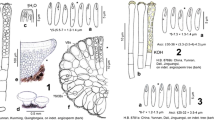Abstract
A new species of Orbilia related to O. luteorubella is described mainly based on morphological characters of its asexual morph and molecular data. The sexual morph does not significantly differ from O. luteorubella, whereas the asexual morph obtained from its ascospore isolate resembles members of the non-predacious genus Dactylella, because it has fusiform phragmoconidia borne singly at the apex of conidiophores. Phylogenetic analysis showed that this strain clustered with a clade that included available strains of the O. luteorubella aggregate and was distant from all analysed Dactylella species. Within this clade, the new strain fell between species with filiform conidia and those of a Pseudotripoconidium anamorph. By combining morphological and phylogenetic analyses, we conclude that our isolate belongs to a new taxon. Pleomorphism of the new taxon is described and discussed.
Similar content being viewed by others
References
Baral, H., Weber, E., Gams, W., Stadler, M., Marvanová, L., Weiß, M., Liu, B., Liu, X., Marson, G., and Hagedorn, G. 2015. Recommendations about Genera to be protected or suppressed in the Orbiliaceae (Orbiliomycetes). Submitted.
Eriksson, O., Baral, H., Currah, R., Hansen, K., Kurtzman, C., Lassoe, T., and Rambold, G. 2003. Notes on ascomycete systematics nos 3580-3623. Myconet. 9, 91–103.
Hagedorn, G. and Scholler, M. 1999. A re-evaluation of predatory orbiliaceous fungi. I. Phylogenetic analysis using rDNA sequence data. Sydowia. 51, 27–48.
Hall, T.A. 1999. Bioedit: A user-friendly biological sequence alignment editor and analysis program for windows 95/98/nt. Nucl. Acids Symp. Ser. 41, 95–98.
Hennebert, G.L. 1987. Pleoanamorphy and its nomenclatural problem, pp. 263–290. In Sugiyama, J. (ed.), Pleomorphic fungi: The diversity and its taxonomic implications, Kodansha Ltd., Tokyo, Japan.
Korf, R.P. 1992. A preliminary discomycete flora of macronesia 8. Orbiliaceae. Mycotaxon. 45, 503–510.
Liu, B. 2006. Ph. D. thesis. Taxonomy and molecular phylogeny of Orbiliaceae from China. Institute of Microbiology, Chinese Academy of Sciences (in Chinese with English abstract).
Mo, M., Huang, X., Zhou, W., Huang, Y., Hao, Y., and Zhang, K.Q. 2005. Arthrobotrys yunnanensis sp. nov., the fourth anamorph of Orbilia auricolor. Fungal Divers. 18, 107–115.
Pfister, D. 1997. Castor, pollux and life histories of fungi. Mycologia 89, 1–23.
Pfister, D. and Liftik, M. 1995. Two Arthrobotrys anamorphs from Orbilia auricolor. Mycologia 87, 684–688.
Qiao, M., Li, J.Y., Baral, H.O., Zhang, Y., Qian, W.Y., Su, H.Y., and Yu, Z.F. 2015. Orbilia yuanensis sp. nov. and its anamorph. Mycol. Prog. 14, 1–7.
Rubner, A. 1996. Revision of predacious hyphomycetes in the Dactylella-Monacrosporium complex. Stud. Mycol. 39, 1–134.
Tamura, K., Stecher, G., Peterson, D., Filipski, A., and Kumar, S. 2013. Mega6: Molecular evolutionary genetics analysis version 6.0. Mol. Biol. Evol. 30, 2725–2729.
Taylor, J.W. 2011. One fungus = one name: DNA and fungal nomenclature twenty years after PCR. IMA Fungus. 2, 113–120.
Thompson, J.D., Gibson, T.J., Plewniak, F., Jeanmougin, F., and Higgins, D.G. 1997. The Clustal_X windows interface: Flexible strategies for multiple sequence alignment aided by quality analysis tools. Nucleic Acids Res. 25, 4876–4882.
Yu, Z., Qiao, M., Zhang, Y., Qin, L., and Zhang, K.Q. 2011. Pseudotripoconidium, a new anamorph genus connected to Orbilia. Mycologia 103, 164–173.
Zhang, Y., Yu, Z.F., Baral, H.O., Qiao, M., and Zhang, K.Q. 2007. Pseudorbilia gen. tnov (Orbiliaceae) from Yunnan, China. Fungal Divers. 26, 305–312.
Author information
Authors and Affiliations
Corresponding author
Additional information
ORCID http://orcid.org/0000-0002-5324-1823
Rights and permissions
About this article
Cite this article
Zhang, Y., Zhang, Y., Dong, J. et al. Orbilia tianmushanensis sp. nov., a new member of the O. luteorubella group with an unusual asexual morph. J Microbiol. 54, 9–13 (2016). https://doi.org/10.1007/s12275-016-5369-4
Received:
Revised:
Accepted:
Published:
Issue Date:
DOI: https://doi.org/10.1007/s12275-016-5369-4




